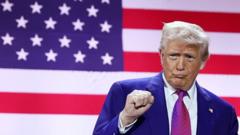President Trump's extravagant claim of over $12 trillion in business investments lacks robust evidence, as many notable investments were pre-planned and only modestly influenced by his administration's policies.
Dissecting Trump's $12 Trillion Investment Assertion: Reality or Rhetoric?

Dissecting Trump's $12 Trillion Investment Assertion: Reality or Rhetoric?
An analysis of President Trump's claims regarding significant business investments during his tenure reveals a stark contrast between promises and actual financial commitments.
The narrative surrounding President Trump's administration has often been adorned with grandiose achievements, particularly regarding business investment. In a recent claim, Trump asserted that over $12 trillion had been "practically committed" to American businesses since he took office. On its face, this figure sounds remarkable, hinting at an unprecedented surge in business investment that could triple the reported $4 trillion from the previous year. However, beneath the surface of this claim lies a more complex reality that invites scrutiny.
As experts point out, reliable data assessing the actual impact of Trump's administration on business investment is still emerging. The U.S. government only releases quarterly statistics on investment, and the early months of Trump’s tenure show a spike largely influenced by an earlier Boeing strike—decidedly not an outcome of his policies. Economist Nick Bloom from Stanford University outlines the prevailing uncertainty in the market, suggesting that business investment might even be on the decline rather than the robust rise claimed by the President.
A prime example to consider is the recent announcement from Swiss pharmaceutical giant Roche, pledging $50 billion in U.S. investments over five years. Notably, many of these investments were underway prior to Trump's presidency, and industry leaders have warned that various proposed policies could derail these plans. The hesitation is compounded when looking at the broader landscape; major commitments touted by Trump from companies like Apple and Hyundai largely consist of previously initiated projects.
An examination of the White House's own data shows the claim of $5.3 trillion in new investments to be significantly inflated. Nearly one-third of the investments, amounting to approximately $134 billion, were set in motion long before Trump’s administration. In fact, many projects listed do not even classify as 'investments' in the conventional sense, instead including existing expenses like employee salaries.
Analysis from Goldman Sachs emphasizes that, after factoring in various risks, expected investments might not exceed $30 billion. This starkly contrasts the President's optimistic portrayals, indicating that the real growth in business investment under Trump's policies may fall short of headline claims.
The White House's responses dodged questions about the discrepancies in reported figures, defending its multifaceted approach to fostering investment as beneficial. Regardless, companies that were approached by the BBC acknowledged that much of their development predated Trump's policies, adding to the narrative of inflated figures.
The incentive to embellish facts is not surprising in the realm of politics, especially when government policies can significantly influence business. Senior fellow Martin Chorzempa notes the strategic motivations for companies to project ambitious goals that align with the current administration’s objectives.
Despite some evidence suggesting that Trump's tariff policies have spurred certain industries, particularly pharmaceuticals, the broader economic effects remain uncertain. Experts like Stephen Farrelly from ING caution that delays in actualizing these investments could yield minimal long-term benefits, particularly in a sector already positioned for growth.
Challenges persist, including industry consolidation and the nature of investments that are shifting towards cheaper technological advancements rather than traditional manufacturing. Economist German Gutierrez argues that while investment appeal is crucial, misdiagnosing the underlying issues—like reduced competition due to dominant players—may hinder true growth.
In conclusion, the ambition to boost investments in the U.S. is clear, yet the methods employed by the Trump administration raise questions about their viability. Critical analysis reveals that achieving substantial economic impact requires more than merely inspiring rhetoric—it necessitates comprehensive strategies that prioritize sustainable growth.






















